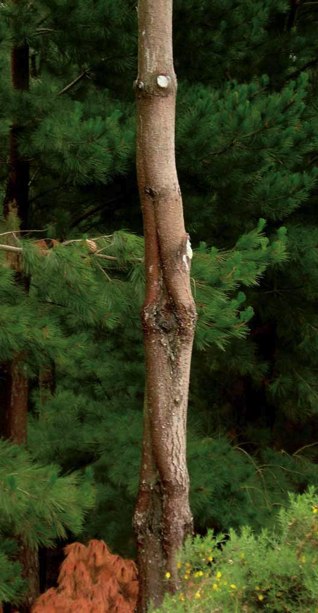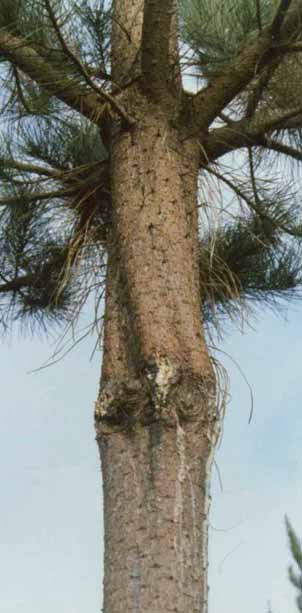PESTS AND DISEASES OF FORESTRY IN NEW ZEALAND
Canker in our pine plantations

From Biosecurity 99, August 2010.
Nectria flute canker demonstrates just how difficult and complex biosecurity problems can be – and the value of science in helping find solutions.
In the mid-1990s, reports started to be heard about significant stem damage on pine trees growing in the southern part of New Zealand. The damage was primarily large flutes or depressions formed above pruned stubs, resulting in poor stem form and sometimes entry points for decay fungi.
By 2002, Crown research institute Scion had determined that a fungus named Neonectria fuckeliana was associated with the damage. The reason identification took so long was because of a series of interacting and complicating factors.
First, the disease symptoms were very similar to those caused by Diplodia whorl canker, a common disease of pines in New Zealand. Second, there are many Nectria and Neonectria species and the taxonomy is very confused. A sample sent to another laboratory was misidentified as Nectria pinea, a common and harmless fungus on pines. Finally, Neonectria fuckeliana was completely new to the southern hemisphere and had never been recorded before on Pinus radiata anywhere in the world. It had previously only been known as a wound invader of spruce and fir trees in the northern hemisphere, demonstrating just how fickle pathogens can be once they start to move into new environments.
So, there was a new fungus in a new part of the world causing new damage on a new host. Overseas research on the fungus was not relevant and researchers had to start from scratch. The response was to go back to basics and start a research programme to examine the ecology of the fungus and its host in order to understand what factors influenced disease development. But that takes time, and the researchers took a punt and established an operational trial designed to determine the influence of season on pruning and pruned-stub treatment on disease development.

A focus group was formed comprising forest growers, MAF Biosecurity New Zealand (MAFBNZ) and researchers, and this group was influential in supporting Scion’s negotiation with the Foundation for Research, Science and Technology (FRST) to divert funding to Neonectria ecology research. Soon after, a four-year funding bid to the Ministry of Agriculture and Forestry (MAF)-administered Forest Industry Development Agenda, to examine the influence of silviculture on disease, wound treatment and disease spread, was successful. After six years of ecological and operational research, we now have an excellent understanding of the disease’s development, behaviour of the fungus and, most importantly, how to manage trees at risk to reduce the impact of the disease. It was found that:
- fluting was more common in the pruned treatment than the unpruned treatment;
- pruning in winter resulted in more disease than summer pruning;
- disease increased for about a year after pruning, decreased over the following three years and then stabilised;
- nearly all flutes associated with pruned branches 60 millimetres or smaller had disappeared, and the tree’s growth had occluded the damage.
The significance of the findings was that the disease can be managed by avoiding winter pruning where possible and changing silvicultural regimes to achieve small pruned-branch stub size.
With a targeted research programme guided and supported by local forest growers, and with the assistance from MAF, the New Zealand Forest Owners’ Association (NZFOA) and FRST, a solution to a potentially serious new biosecurity threat has been found. The example of Neonectria fuckeliana in New Zealand demonstrates the value of science in helping to solve the unique problems that are constantly present within the biosecurity sector.
Lindsay Bulman, Project Leader Forest Biosecurity, Scion, lindsay.bulman@scionresearch.com

 Farm Forestry New Zealand
Farm Forestry New Zealand

